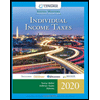
TAXATION OF INDIVIDUALS AND BUSINESS EN
11th Edition
ISBN: 9781264096329
Author: SPILKER
Publisher: MCG
expand_more
expand_more
format_list_bulleted
Question
Chapter 15, Problem 1DQ
To determine
List the most common legal entities that are used for operating a business. Discuss how these entities are similar and different for state law purposes.
Expert Solution & Answer
Explanation of Solution
The following are the most common legal entities that are used for operating a business:
- Corporations.
- Limited liability Companies (LLCs).
Partnerships .- Sole Proprietorships.
The following are the similarity of the above entities for state law purposes:
- The state laws protect all the members or owners of Corporations and LLCs from personal legal entities.
- Corporations, Limited liability Companies (LLCs), and Partnerships are identified as business entities for state law purposes.
The following are the differences among the above entities for state law purposes:
- The legal rights and responsibilities, and number of owners of each entity are different from other.
- The tax rule to determine tax on the entities and their owners are different from each other.
Want to see more full solutions like this?
Subscribe now to access step-by-step solutions to millions of textbook problems written by subject matter experts!
Students have asked these similar questions
DC Co. exchanged equipment and $25,000 cash for similar equipment. The book value and fair value of the old equipment were $120,000 and $135,000, respectively. Assuming that the exchange has commercial substance, DC would record a gain/(loss) of __.
Please show me the valid approach to solving this financial accounting problem with correct methods.
Help with accounting question
Chapter 15 Solutions
TAXATION OF INDIVIDUALS AND BUSINESS EN
Knowledge Booster
Similar questions
- Which accounting principle requires that expenses be recorded in the same period as the revenues they help generate?A. Cost PrincipleB. Revenue Recognition PrincipleC. Matching PrincipleD. Full Disclosure Principlearrow_forwardI need guidance with this financial accounting problem using the right financial principles.arrow_forwardWhat is the formula for calculating the weighted average cost of capital (WACC)?A) WACC = (Cost of Debt × Proportion of Debt) + (Cost of Equity × Proportion of Equity)B) WACC = (Cost of Debt + Cost of Equity) / 2C) WACC = Cost of Debt + Cost of EquityD) WACC = Proportion of Debt + Proportion of Equityarrow_forward
- If a company has annual sales of $840,000 with a gross profit margin of 35%, what is the cost of goods sold?arrow_forwardKindly help me with general accounting questionarrow_forwardA business purchased a machine for $120,000 with an estimated useful life of 8 years and salvage value of $24,000. What is the annual straight-line depreciation amount? Helparrow_forward
- Windsor Manufacturing had budgeted overhead costs of $420,000 for the year. The company applied $420,000 of overhead, but the actual overhead incurred amounted to $435,000. Based on this information, what are the fixed overhead price variance for Windsor Manufacturing?arrow_forwardFinancial Accounting Questionarrow_forwardPlease provide the answer to this general accounting question using the right approach.arrow_forward
arrow_back_ios
SEE MORE QUESTIONS
arrow_forward_ios
Recommended textbooks for you
- Century 21 Accounting Multicolumn JournalAccountingISBN:9781337679503Author:GilbertsonPublisher:Cengage
 Individual Income TaxesAccountingISBN:9780357109731Author:HoffmanPublisher:CENGAGE LEARNING - CONSIGNMENT
Individual Income TaxesAccountingISBN:9780357109731Author:HoffmanPublisher:CENGAGE LEARNING - CONSIGNMENT

Century 21 Accounting Multicolumn Journal
Accounting
ISBN:9781337679503
Author:Gilbertson
Publisher:Cengage


Individual Income Taxes
Accounting
ISBN:9780357109731
Author:Hoffman
Publisher:CENGAGE LEARNING - CONSIGNMENT


